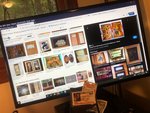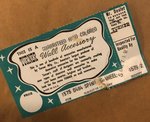Dear every artist I’ve ever met, please forgive me, for I know not what I do.
Oh, sure, I strut around the Upper Delaware River region claiming to know “a little bit about a lot of …
Stay informed about your community and support local independent journalism.
Subscribe to The River Reporter today. click here
This item is available in full to subscribers.
Please log in to continueNeed an account?
|




In my humble opinion
Dear every artist I’ve ever met, please forgive me, for I know not what I do.
Oh, sure, I strut around the Upper Delaware River region claiming to know “a little bit about a lot of things” including art in every form, but if I’ve learned anything in the last few weeks, it would be that I’m a bit of a jerk with zero taste level; one who appreciates what is commonly known as “kitsch”—aka the lowest common denominator in the art world.
While vacationing in a lakeside cottage with gal-pal Lynne a few weeks ago, I came across, and became enamored with, a piece of “mid-century art” that caught my eye. Every time I walked past the “painting,” it glinted, catching the light in a way I had never seen before. The large, framed masterpiece depicted what can only be described as a colonial-era great room, replete with a braided rug, rocking chair, and breakfront brimming with brightly colored, somewhat metallic tchotchkes. Upon closer examination, I realized that the “painting” was three-dimensional and made out of molded plastic.
Don’t ask me why, but I couldn’t take my eyes off of the thing, and when I suggested to Lynne that I was going to ask our host if I could buy it, she recoiled. “No,” she said, “you’re not. It’s hideous. I won’t let you do it. This isn’t art!” she declared.
“Are you sure?” I asked. “After all, one man’s trash is another man’s treasure, right?” I gingerly took the painting off the wall for closer examination. Turning it over, I found a label adhered to the back, along with a dead spider and an inch of dust. “This is a Turner Guaranteed Hand Colored Wall Accessory” the tattered paper boldly informed, “by Turner Manufacturing Co., America’s largest producer of decorative accessories for the home.” It didn’t say “hand-painted” mind you, but rather “hand colored.”
“What do you think of that?” I asked Lynne. “Hand colored!”
“That doesn’t make it art,” she replied. “You’re not buying it.” She didn’t let me near our B&B hosts for the rest of our visit, and even though we went antique shopping a few times, nobody had heard of the company. Still fascinated, I went back to the label for even more information. “Turner’s staff of designers is constantly creating new types of decorator wall accessories to make your home smarter, brighter and lovelier.” Really now, who doesn’t want that?
Upon returning to civilization and WiFi, I asked the Google about my obsession.
“Based in Chicago, the Turner Manufacturing Company produced a variety of prints and paintings [there’s that word again] for roughly thirty years,” I learned, “and many of them can still be bought to this day. However, the cost of appraising most of these pieces usually exceeds their actual value.”
Even more intrigued, I spiraled down a rabbit hole, wanting to know more. “Turner wall art was designed for casual house design rather than art collection, and it was often sold at affordable prices in department and outlet stores.”
I immediately started hunting online for the piece I had fallen in love with, curious to know what it was gonna cost me, since Lynne had returned to Massachusetts, far from my computer.
“Because of the high supply and low initial value, vintage Turner wall accessories have not significantly appreciated in value, and you can still buy them cheaply today despite no longer being made.” Tingling with tasteless excitement, I continued reading. “While the company was modestly successful in its heyday, unlike more valuable antiques, there is no standard pricing guide for Turner wall prints, so they are worth only what people are willing to pay for them.”
By this point, I was definitely willing to cough up a few bucks for a “wall accessory” that has “survived in large numbers in part because they were made with man-made materials such as plastic that are resistant to moisture, heat and light degradation,” according to Wikipedia.
“Unlike more expensive natural materials, I read, “Turner wall art wasn’t considered high-quality when it was first sold, and that hasn’t changed much today.”
I found a molded-plastic still-life online for twelve bucks. Then another for eighteen, but none were the piece I coveted, none had a three-dimensional butter churn (uh huh) or brightly hued ball of yarn, but the one I landed was strikingly similar, with a copper-colored cauldron, glittery ceiling beams and three-dimensional cat curled up by a “glowing” fire. Better still: its value had not “significantly appreciated” since Eisenhower was in the White House. At $28, (with shipping) I gleefully ordered it and called Lynne to taunt her, informing that by the time she returned for another visit, I’d be the proud owner of a guaranteed hand-colored, three-dimensional plastic Turner Wall accessory, circa 1955.
“Knock yourself out,” she chortled. “I wouldn’t have it in my home. Not a big fan of kitsch.”
It arrived, without any dead spiders attached, and since it was composed solely of man-made materials, I decided to chance washing it with Windex, which made it sparkle.
Since I was already down the rabbit hole, I looked up “kitsch,” to make sure I understood its meaning, stunned to learn that it’s a Yiddish word. “Well, that makes sense,” I said to the dog. “Maybe it’s genetic.”
“Kitsch is art or other objects that, generally speaking, appeal to popular rather than ‘high art’ tastes,” the Google informed. “Such objects are sometimes appreciated in a humorous way that few [not counting Lynne] would find disagreeable, shocking or otherwise objectionable; it may also be quaint or ‘quirky’ without being controversial.”
Since I’ve been called far worse (IMHO) than “quaint and quirky” (Attorneys at Law) I’m OK with that. Besides, to brand visual art as “kitsch” is “generally (but not exclusively) pejorative, as it implies that the work in question is ‘gaudy,’ or that it serves a solely ornamental and decorative purpose rather than amounting to a work of what may be seen as ‘true artistic merit’,” and I’m OK with that.
Ask the Google: What is kitsch?
Answer: “Art, objects, or design considered to be in poor taste because of excessive garishness or sentimentality, but sometimes appreciated in an ironic or knowing way—the lava lamp is an example of sixties kitsch.”
Fun Fact: “One man’s trash” is an old proverb of unknown origin, and it means that “something that one person considers worthless may be considered valuable by someone else.” Example given: “Why would anyone want to hang a picture like that on the wall?”
Related stories

Comments
No comments on this item Please log in to comment by clicking here